System Development Life Cycle (SDLC) - A Survey
47 Pages18551 Words217 Views
Added on 2021-08-23
About This Document
SAD Submitted by Dipak Chhetri (HND / Second Semester) SUBMITTED TO: Kamal Dhakal SAD Contents Task 1: 5 Introduction5 1.2 System Development Life Cycle (SDLC):. 6 Testing 7 Deployment:7 1.340 SDLC models 7 1.3.1 Waterfall model: . 10 Strength of Spiral Model:11 Weakness of Spiral model: 11 1.3.3 Prototype model 11 Advantages of Prototype model. 13 Advantages of the RAD model 14 Disadvantages of the RAD model14 1.3.5 Agile model 15
System Development Life Cycle (SDLC) - A Survey
Added on 2021-08-23
ShareRelated Documents
Submitted by Dipak Chhetri (HND / Second Semester)
SUBMITTED TO: Kamal Dhakal
SAD
SUBMITTED TO: Kamal Dhakal
SAD

SAD
Submitted by Dipak Chhetri (HND / Second Semester)
1
Contents
Task 1: ................................................................................................................................................ 5
Introduction ............................................................................................................................................ 5
1.2 System Development Life Cycle (SDLC): ......................................................................................... 5
Planning: ............................................................................................................................................. 6
Defining requirements: ........................................................................................................................ 6
Systems Design: .................................................................................................................................. 6
Development of product: ..................................................................................................................... 6
Testing ................................................................................................................................................ 7
Deployment: ........................................................................................................................................ 7
1.3 SDLC models.................................................................................................................................... 7
1.3.1 Waterfall model: ......................................................................................................................... 7
Advantages of Waterfall model ....................................................................................................... 8
Disadvantages of waterfall model are given below: ......................................................................... 9
1.3.2Spiral Model ................................................................................................................................ 9
Phases of spiral model ................................................................................................................... 10
Advantages of spiral model ........................................................................................................... 10
Disadvantages of spiral model ....................................................................................................... 10
Strength of Spiral Model: .............................................................................................................. 11
Weakness of Spiral model: ............................................................................................................ 11
1.3.3 Prototype model........................................................................................................................ 11
Advantages of Prototype model ..................................................................................................... 12
Disadvantages of prototype model ................................................................................................. 13
1.3.4 RAD (Rapid Application Development) ................................................................................... 13
Advantages of the RAD model ...................................................................................................... 14
Disadvantages of the RAD model .................................................................................................. 14
1.3.5 Agile model .............................................................................................................................. 15
Submitted by Dipak Chhetri (HND / Second Semester)
1
Contents
Task 1: ................................................................................................................................................ 5
Introduction ............................................................................................................................................ 5
1.2 System Development Life Cycle (SDLC): ......................................................................................... 5
Planning: ............................................................................................................................................. 6
Defining requirements: ........................................................................................................................ 6
Systems Design: .................................................................................................................................. 6
Development of product: ..................................................................................................................... 6
Testing ................................................................................................................................................ 7
Deployment: ........................................................................................................................................ 7
1.3 SDLC models.................................................................................................................................... 7
1.3.1 Waterfall model: ......................................................................................................................... 7
Advantages of Waterfall model ....................................................................................................... 8
Disadvantages of waterfall model are given below: ......................................................................... 9
1.3.2Spiral Model ................................................................................................................................ 9
Phases of spiral model ................................................................................................................... 10
Advantages of spiral model ........................................................................................................... 10
Disadvantages of spiral model ....................................................................................................... 10
Strength of Spiral Model: .............................................................................................................. 11
Weakness of Spiral model: ............................................................................................................ 11
1.3.3 Prototype model........................................................................................................................ 11
Advantages of Prototype model ..................................................................................................... 12
Disadvantages of prototype model ................................................................................................. 13
1.3.4 RAD (Rapid Application Development) ................................................................................... 13
Advantages of the RAD model ...................................................................................................... 14
Disadvantages of the RAD model .................................................................................................. 14
1.3.5 Agile model .............................................................................................................................. 15
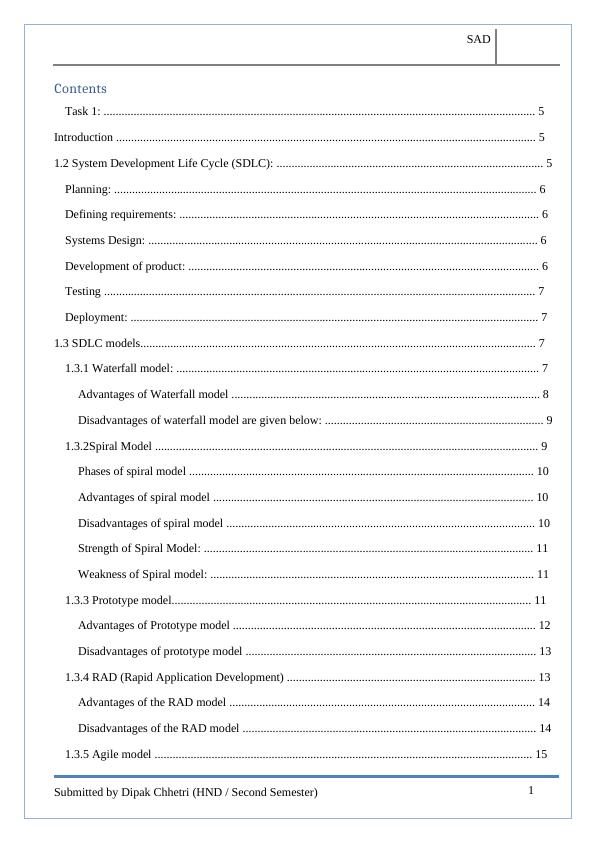
SAD
Submitted by Dipak Chhetri (HND / Second Semester)
2
Advantages of Agile model ........................................................................................................... 16
Disadvantages of Agile model ....................................................................................................... 16
1.3.6 DSDM (Dynamic System Development Method) ..................................................................... 16
Advantages of DSDM model......................................................................................................... 17
Disadvantages of DSDM model .................................................................................................... 17
1.4 Conclusion: ..................................................................................................................................... 17
Task 2 ................................................................................................................................................... 18
2.1 Introduction .................................................................................................................................... 18
2.2) Importance of System Investigation ............................................................................................... 18
2.3 Stages of system development life cycle .......................................................................................... 19
2.3.1 Planning ................................................................................................................................... 19
2.3.2 Questionnaires: ......................................................................................................................... 19
2.3.3 Implementation ......................................................................................................................... 20
2.3.4 Testing: .................................................................................................................................... 20
2.3.5 Review: .................................................................................................................................... 20
2.3.6 Record View ............................................................................................................................. 21
2.4 Conclusion ...................................................................................................................................... 21
Task 3 ................................................................................................................................................... 21
3.1 Introduction .................................................................................................................................... 21
3.2 Benefits of Feasibility study ............................................................................................................ 21
3.2.1Technical feasibility................................................................................................................... 22
3.2.2 Economic Feasibility ................................................................................................................ 22
3.2.3 Legal Feasibility: ...................................................................................................................... 22
3.2.4 Operational feasibility............................................................................................................... 23
3.2.5 Schedule feasibility ................................................................................................................... 23
3.2.6 Social Feasibility ...................................................................................................................... 23
3.2.7 Purpose of Feasibility report: .................................................................................................... 24
Submitted by Dipak Chhetri (HND / Second Semester)
2
Advantages of Agile model ........................................................................................................... 16
Disadvantages of Agile model ....................................................................................................... 16
1.3.6 DSDM (Dynamic System Development Method) ..................................................................... 16
Advantages of DSDM model......................................................................................................... 17
Disadvantages of DSDM model .................................................................................................... 17
1.4 Conclusion: ..................................................................................................................................... 17
Task 2 ................................................................................................................................................... 18
2.1 Introduction .................................................................................................................................... 18
2.2) Importance of System Investigation ............................................................................................... 18
2.3 Stages of system development life cycle .......................................................................................... 19
2.3.1 Planning ................................................................................................................................... 19
2.3.2 Questionnaires: ......................................................................................................................... 19
2.3.3 Implementation ......................................................................................................................... 20
2.3.4 Testing: .................................................................................................................................... 20
2.3.5 Review: .................................................................................................................................... 20
2.3.6 Record View ............................................................................................................................. 21
2.4 Conclusion ...................................................................................................................................... 21
Task 3 ................................................................................................................................................... 21
3.1 Introduction .................................................................................................................................... 21
3.2 Benefits of Feasibility study ............................................................................................................ 21
3.2.1Technical feasibility................................................................................................................... 22
3.2.2 Economic Feasibility ................................................................................................................ 22
3.2.3 Legal Feasibility: ...................................................................................................................... 22
3.2.4 Operational feasibility............................................................................................................... 23
3.2.5 Schedule feasibility ................................................................................................................... 23
3.2.6 Social Feasibility ...................................................................................................................... 23
3.2.7 Purpose of Feasibility report: .................................................................................................... 24
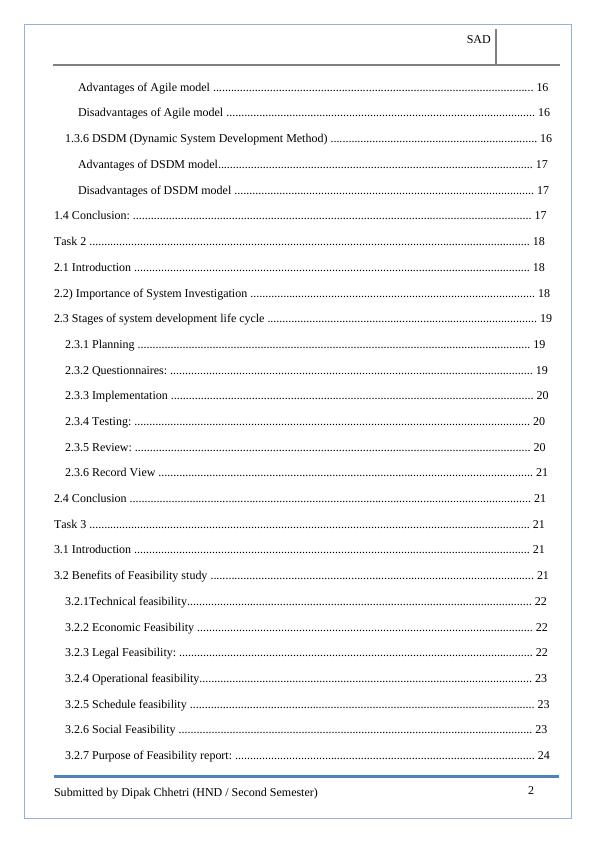
SAD
Submitted by Dipak Chhetri (HND / Second Semester)
3
3.3 Document structure ......................................................................................................................... 24
3.4 Conclusion: ..................................................................................................................................... 24
Task 4 ................................................................................................................................................... 25
4.1 Introduction .................................................................................................................................... 25
4.2 Fact finding techniques ................................................................................................................... 25
4.3 Fact-Finding techniques .................................................................................................................. 26
4.3.1 Questionnaires: ......................................................................................................................... 26
4.3.2 Investigation of document ......................................................................................................... 26
4.3.3 Observations ............................................................................................................................. 27
4.3.4 Focus Group: ............................................................................................................................ 27
4.3.5 Research & Site Visits .............................................................................................................. 28
4.4 Feasibility criteria on a system investigation of Falcon College ....................................................... 28
4.4.1 Technical Feasibility ................................................................................................................. 28
4.4.2 Economical feasibility .............................................................................................................. 28
4.4.3 Timescales ................................................................................................................................ 29
4.4.4 Social Feasibility: ..................................................................................................................... 29
4.5 Conclusion ...................................................................................................................................... 29
Task 5 ................................................................................................................................................... 30
5.1) Introduction ................................................................................................................................... 30
5.2) Existing system Investigation ......................................................................................................... 30
5.2.1 Current system .......................................................................................................................... 30
5.2.2) Limitations of the current system ............................................................................................. 30
5.3) Investigation of the new system and its design ............................................................................... 31
5.4 Stakeholders .................................................................................................................................... 31
5.5) Stakeholder requirements identification ......................................................................................... 31
5.6 Constraints: ..................................................................................................................................... 32
5.7 Legacy systems: .............................................................................................................................. 33
Submitted by Dipak Chhetri (HND / Second Semester)
3
3.3 Document structure ......................................................................................................................... 24
3.4 Conclusion: ..................................................................................................................................... 24
Task 4 ................................................................................................................................................... 25
4.1 Introduction .................................................................................................................................... 25
4.2 Fact finding techniques ................................................................................................................... 25
4.3 Fact-Finding techniques .................................................................................................................. 26
4.3.1 Questionnaires: ......................................................................................................................... 26
4.3.2 Investigation of document ......................................................................................................... 26
4.3.3 Observations ............................................................................................................................. 27
4.3.4 Focus Group: ............................................................................................................................ 27
4.3.5 Research & Site Visits .............................................................................................................. 28
4.4 Feasibility criteria on a system investigation of Falcon College ....................................................... 28
4.4.1 Technical Feasibility ................................................................................................................. 28
4.4.2 Economical feasibility .............................................................................................................. 28
4.4.3 Timescales ................................................................................................................................ 29
4.4.4 Social Feasibility: ..................................................................................................................... 29
4.5 Conclusion ...................................................................................................................................... 29
Task 5 ................................................................................................................................................... 30
5.1) Introduction ................................................................................................................................... 30
5.2) Existing system Investigation ......................................................................................................... 30
5.2.1 Current system .......................................................................................................................... 30
5.2.2) Limitations of the current system ............................................................................................. 30
5.3) Investigation of the new system and its design ............................................................................... 31
5.4 Stakeholders .................................................................................................................................... 31
5.5) Stakeholder requirements identification ......................................................................................... 31
5.6 Constraints: ..................................................................................................................................... 32
5.7 Legacy systems: .............................................................................................................................. 33
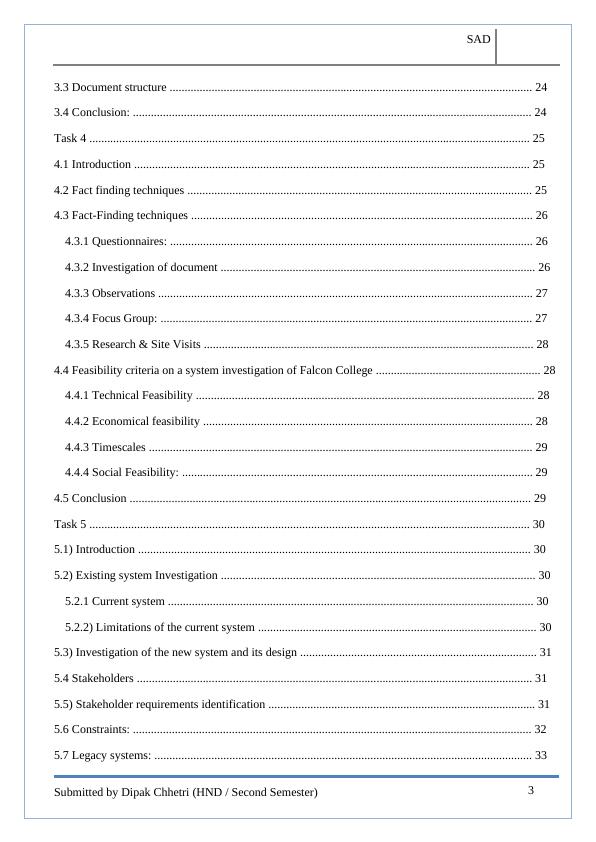
SAD
Submitted by Dipak Chhetri (HND / Second Semester)
4
5.8 Hardware platforms:........................................................................................................................ 33
5.9 Upgrading computer systems: ......................................................................................................... 33
5.10 Designing new system ................................................................................................................... 34
5.11 Conclusion .................................................................................................................................... 34
Task 6 ................................................................................................................................................... 35
6.1 Introduction .................................................................................................................................... 35
6.2 Context Diagram ............................................................................................................................. 35
6.3 Use Case Diagram ........................................................................................................................... 36
6.4 DFD ................................................................................................................................................ 37
6.5) ER diagram .................................................................................................................................... 39
6.6 Conclusion ...................................................................................................................................... 40
Task 7 ................................................................................................................................................... 41
7.1 Introduction .................................................................................................................................... 41
7.2) Purpose (Background Information) ................................................................................................ 41
7.3) Scope of work ................................................................................................................................ 42
7.4 Data collection process .................................................................................................................... 42
7.5 Summary......................................................................................................................................... 43
7.6 Recommendation ............................................................................................................................ 43
7.8 Conclusion ...................................................................................................................................... 44
Reference .............................................................................................................................................. 45
Submitted by Dipak Chhetri (HND / Second Semester)
4
5.8 Hardware platforms:........................................................................................................................ 33
5.9 Upgrading computer systems: ......................................................................................................... 33
5.10 Designing new system ................................................................................................................... 34
5.11 Conclusion .................................................................................................................................... 34
Task 6 ................................................................................................................................................... 35
6.1 Introduction .................................................................................................................................... 35
6.2 Context Diagram ............................................................................................................................. 35
6.3 Use Case Diagram ........................................................................................................................... 36
6.4 DFD ................................................................................................................................................ 37
6.5) ER diagram .................................................................................................................................... 39
6.6 Conclusion ...................................................................................................................................... 40
Task 7 ................................................................................................................................................... 41
7.1 Introduction .................................................................................................................................... 41
7.2) Purpose (Background Information) ................................................................................................ 41
7.3) Scope of work ................................................................................................................................ 42
7.4 Data collection process .................................................................................................................... 42
7.5 Summary......................................................................................................................................... 43
7.6 Recommendation ............................................................................................................................ 43
7.8 Conclusion ...................................................................................................................................... 44
Reference .............................................................................................................................................. 45
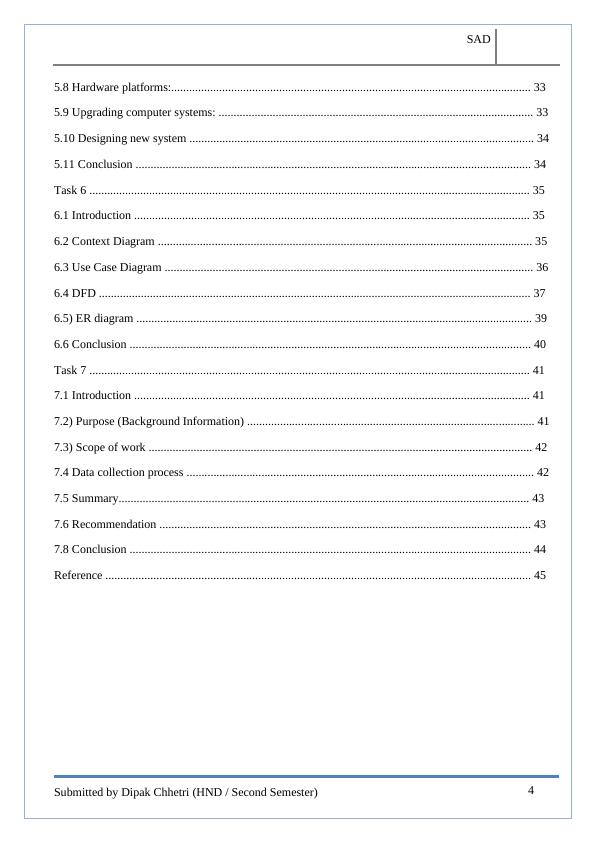
SAD
Submitted by Dipak Chhetri (HND / Second Semester)
5
Task 1:
Evaluate different systems lifecycle models [1.1, M1]
Consider: SDLC models: Waterfall, Spiral, Prototyping, RAD, Agile and DSDM models.
In order to achieve M1, your writing need to demonstrate that an effective approach to study and research
has been applied when evaluating different systems lifecycle models.
Introduction
As technology has been common and have been playing a great role in our daily work making our work
easier and comfortable. Everyday different technology has been invented by the help of technology we are
able to perform any tasks. Similarly, Falcon College also wants to make their work easier and help their
students in order to perform their task by developing technologies. As the falcon college has traditional
information system software that manages the academic records of students and faculty members but now
the college is facing various issues while maintaining and updating the academic needs online. So, the
college has design and develop a simple and intuitive system called an Academic Portal in order to improve
or mitigate those issues.
1.2 System Development Life Cycle (SDLC):
The framework improvement life cycle is the applied model utilized as a part of the venture administration
that depicts the stages required in a data framework advancement extend. There are a wide range of SDLC
models and procedures that comprise of a progression of characterized steps or stages. Framework
advancement life cycle (SDLC) prepare applies to guarantee that all the utilitarian and client prerequisites
and organization techniques objectives and destinations are met (Rouse, 2009). All framework
advancement ventures take after basically a similar crucial process called the framework improvement life
cycle (SDLC). The SDLC begins with an arranging stage in which the venture group identifies the business
estimation of the framework, leads a possibility examination, and arrangements the venture. The second
stage is the examination stage, in which the group builds up an investigation procedure, assembles data,
and fabricates an arrangement of examination models. In the following stage, the outline stage, the group
builds up the plan system, the physical outline, engineering plan, interface plan, database and file
specifications, and program plan. In the final stage, usage, the framework is assembled, introduced, and
looked after (Wixom, 2005). SDLC helps in applying hazard administration prepare so that framework
improvement empowers associations to adjust prerequisites for the insurance of office data and resources
Submitted by Dipak Chhetri (HND / Second Semester)
5
Task 1:
Evaluate different systems lifecycle models [1.1, M1]
Consider: SDLC models: Waterfall, Spiral, Prototyping, RAD, Agile and DSDM models.
In order to achieve M1, your writing need to demonstrate that an effective approach to study and research
has been applied when evaluating different systems lifecycle models.
Introduction
As technology has been common and have been playing a great role in our daily work making our work
easier and comfortable. Everyday different technology has been invented by the help of technology we are
able to perform any tasks. Similarly, Falcon College also wants to make their work easier and help their
students in order to perform their task by developing technologies. As the falcon college has traditional
information system software that manages the academic records of students and faculty members but now
the college is facing various issues while maintaining and updating the academic needs online. So, the
college has design and develop a simple and intuitive system called an Academic Portal in order to improve
or mitigate those issues.
1.2 System Development Life Cycle (SDLC):
The framework improvement life cycle is the applied model utilized as a part of the venture administration
that depicts the stages required in a data framework advancement extend. There are a wide range of SDLC
models and procedures that comprise of a progression of characterized steps or stages. Framework
advancement life cycle (SDLC) prepare applies to guarantee that all the utilitarian and client prerequisites
and organization techniques objectives and destinations are met (Rouse, 2009). All framework
advancement ventures take after basically a similar crucial process called the framework improvement life
cycle (SDLC). The SDLC begins with an arranging stage in which the venture group identifies the business
estimation of the framework, leads a possibility examination, and arrangements the venture. The second
stage is the examination stage, in which the group builds up an investigation procedure, assembles data,
and fabricates an arrangement of examination models. In the following stage, the outline stage, the group
builds up the plan system, the physical outline, engineering plan, interface plan, database and file
specifications, and program plan. In the final stage, usage, the framework is assembled, introduced, and
looked after (Wixom, 2005). SDLC helps in applying hazard administration prepare so that framework
improvement empowers associations to adjust prerequisites for the insurance of office data and resources
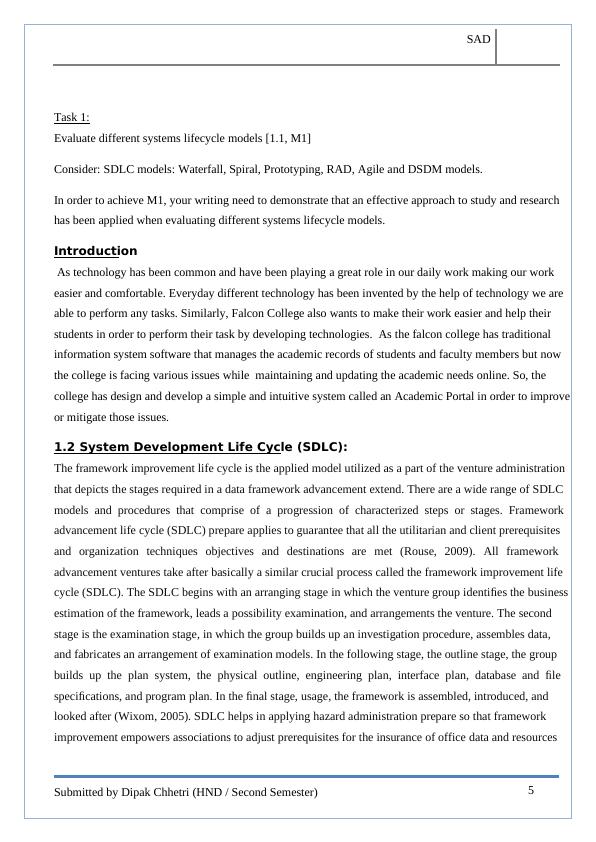
SAD
Submitted by Dipak Chhetri (HND / Second Semester)
6
with the cost of security controls and moderation techniques. A portion of the procedure of System
Development Life Cycle (SDLC) is:
Fig: Stages of System Development Life Cycle (SDLC):
Planning:
In this stage, associations build up requirements for framework and archives. Start stage distinguish
security arranging with the key security part for the improvement of framework. The data that will be
handled, transmitted or put away is assessed for security necessities and all partners have a typical
comprehension towards security contemplations and data is recognized also.
Defining requirements:
After completion of the analysis of the requirements then they are documented and by business analyst
they are approved. In Software Requirement Specification, the requirement is documented.
Systems Design:
System design determine the functional need for the purposed system and prepare the module of
requirement that are collected through analysis. Objectives are included clearly within module that
helps to develop the operational system.
Development of product:
Through the proper design in previous phase, it includes the real code for the purposed system.
Different programmer, network engineer and/or database developer are included to develop the
Submitted by Dipak Chhetri (HND / Second Semester)
6
with the cost of security controls and moderation techniques. A portion of the procedure of System
Development Life Cycle (SDLC) is:
Fig: Stages of System Development Life Cycle (SDLC):
Planning:
In this stage, associations build up requirements for framework and archives. Start stage distinguish
security arranging with the key security part for the improvement of framework. The data that will be
handled, transmitted or put away is assessed for security necessities and all partners have a typical
comprehension towards security contemplations and data is recognized also.
Defining requirements:
After completion of the analysis of the requirements then they are documented and by business analyst
they are approved. In Software Requirement Specification, the requirement is documented.
Systems Design:
System design determine the functional need for the purposed system and prepare the module of
requirement that are collected through analysis. Objectives are included clearly within module that
helps to develop the operational system.
Development of product:
Through the proper design in previous phase, it includes the real code for the purposed system.
Different programmer, network engineer and/or database developer are included to develop the

SAD
Submitted by Dipak Chhetri (HND / Second Semester)
7
coding on the project. While coding flowchart is used in order to confirm that the process of the
system is properly organized.
Testing
After execution of the system, bringing every one of the parts and subsystems together and making the
entire incorporated system for testing is a due obligation of a developer. Testing the elements of the system
giving input and breaking down the output guarantee the fulfillment to the client or an association. Testing
can be performed by genuine users or by a group of specific faculty. The whole testing process is basically
divided into unit testing, assembly testing and system testing in three phases. The fundamental techniques
for testing are white box test and discovery test.
Deployment: Once the product is tested and ready to deployed, it is released formally in the market.
Sometimes the product deployment happens in stages as per the business strategy of that organization. At
first the business firm may release the limited segment of the product to test the product in the real business
environment. Then based on the feedback, the product may be released as it is or with suggested
enhancements in the targeting market segment.
1.3 SDLC models
Following SDLC models can be taken into account while developing a software or an application.
1.3.1 Waterfall model:
In 1970, Winston W. Royce introduced the waterfall model with defining it as linear Sequential lifecycle
model. Where waterfall model follow the sequential order. To move on next phases of development of
system, the previous phase must be complete. Through comprehensive requirement of small project, it is
very helpful in order to complete the project. Once we complete the phase we cannot revert back to modify
the problem. For the modification, we must develop the new system with additional concept of existing
system. Testing phase is placed in downward due to its supportive behavior for the waterfall model.
Submitted by Dipak Chhetri (HND / Second Semester)
7
coding on the project. While coding flowchart is used in order to confirm that the process of the
system is properly organized.
Testing
After execution of the system, bringing every one of the parts and subsystems together and making the
entire incorporated system for testing is a due obligation of a developer. Testing the elements of the system
giving input and breaking down the output guarantee the fulfillment to the client or an association. Testing
can be performed by genuine users or by a group of specific faculty. The whole testing process is basically
divided into unit testing, assembly testing and system testing in three phases. The fundamental techniques
for testing are white box test and discovery test.
Deployment: Once the product is tested and ready to deployed, it is released formally in the market.
Sometimes the product deployment happens in stages as per the business strategy of that organization. At
first the business firm may release the limited segment of the product to test the product in the real business
environment. Then based on the feedback, the product may be released as it is or with suggested
enhancements in the targeting market segment.
1.3 SDLC models
Following SDLC models can be taken into account while developing a software or an application.
1.3.1 Waterfall model:
In 1970, Winston W. Royce introduced the waterfall model with defining it as linear Sequential lifecycle
model. Where waterfall model follow the sequential order. To move on next phases of development of
system, the previous phase must be complete. Through comprehensive requirement of small project, it is
very helpful in order to complete the project. Once we complete the phase we cannot revert back to modify
the problem. For the modification, we must develop the new system with additional concept of existing
system. Testing phase is placed in downward due to its supportive behavior for the waterfall model.
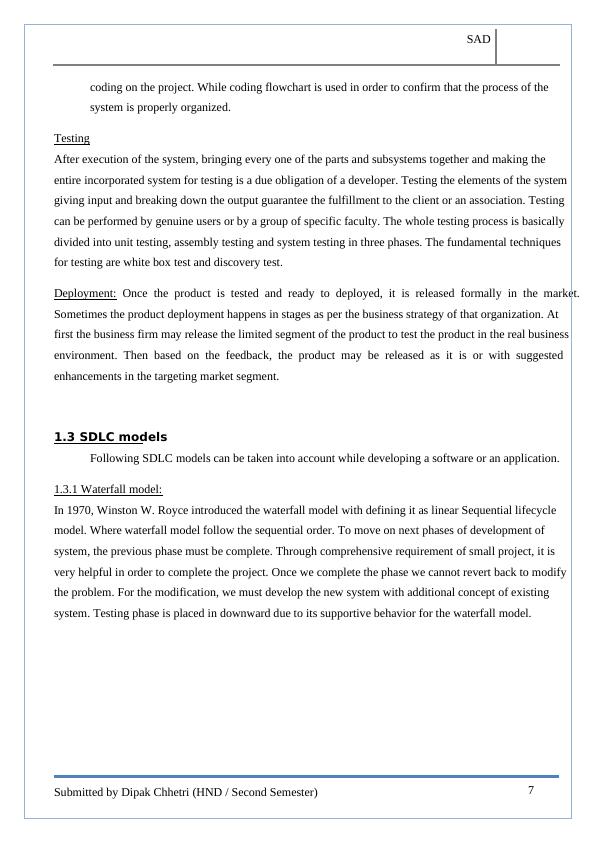
End of preview
Want to access all the pages? Upload your documents or become a member.
Related Documents
Software Development Lifecycles PDFlg...
|107
|33743
|261
Assignment on Software Development Life Cyclelg...
|37
|7409
|54
System Analysis & Design : Software Development Life Cyclelg...
|46
|10454
|242
Transmission Control Protocol/Internet Protocol PDFlg...
|88
|24971
|186
Systems Analysis and Design for Adroit Ads Companylg...
|29
|5985
|419
System Analysis: Feasibility Study and Lifecycle Modelslg...
|24
|4376
|346
